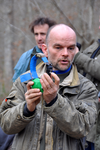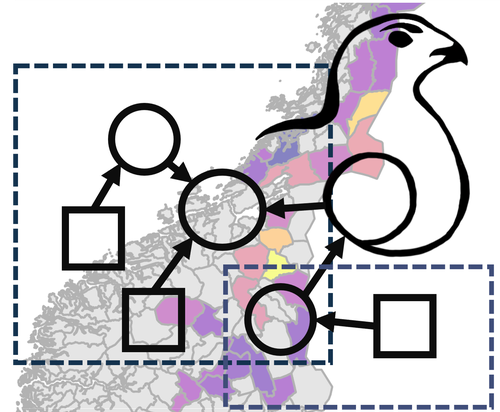
HEWISON Aidan Jonathan Mark
- CEFS, INRAE, Castanet-Tolosan, France
- Behaviour & Ethology, Demography, Dispersal & Migration, Evolutionary ecology, Habitat selection, Life history, Maternal effects, Population ecology, Social structure
- recommender
Recommendation: 1
Review: 1
Recommendation: 1

Large-scale spatio-temporal variation in vital rates and population dynamics of an alpine bird
Do look up: building a comprehensive view of population dynamics from small scale observation through citizen science
Recommended by Aidan Jonathan Mark Hewison based on reviews by Todd Arnold and 1 anonymous reviewerPopulation ecologists are in the business of decrypting the drivers of variation in the abundance of organisms across space and time (Begon et al. 1986). Comprehensive studies of wild vertebrate populations which provide the necessary information on variations in vital rates in relation to environmental conditions to construct informative models of large-scale population dynamics are rare, ostensibly because of the huge effort required to monitor individuals across ecological contexts and over generations. In this current aim, Nater et al. (2024) are leading the way forward by combining distance sampling data collected through a large-scale citizen science (Fraisl et al. 2022) programme in Norway with state-of-the-art modelling approaches to build a comprehensive overview of the population dynamics of willow ptarmigan. Their work enhances our fundamental understanding of this system and provides evidence-based tools to improve its management (Williams et al. 2002). Even better, they are working for the common good, by providing an open-source workflow that should enable ecologists and managers together to predict what will happen to their favourite model organism when the planet throws its next curve ball. In the case of the ptarmigan, for example, it seems that the impact of climate change on their population dynamics will differ across the species’ distributional range, with a slower pace of life (sensu Stearns 1983) at higher latitudes and altitudes.
On a personal note, I have often mused whether citizen science, with its inherent limits and biases, was just another sticking plaster over the ever-deeper cuts in the research budgets to finance long-term ecological research. Here, Nater et al. are doing well to convince me that we would be foolish to ignore such opportunities, particularly when citizens are engaged, motivated, with an inherent capacity for the necessary discipline to employ common protocols in a standardised fashion. A key challenge for us professional ecologists is to inculcate the next generation of citizens with a sense of their opportunity to contribute to a better understanding of the natural world.
References
Begon, Michael, John L Harper, and Colin R Townsend. 1986. Ecology: individuals, populations and communities. Blackwell Science.
Fraisl, Dilek, Gerid Hager, Baptiste Bedessem, Margaret Gold, Pen-Yuan Hsing, Finn Danielsen, Colleen B Hitchcock, et al. 2022. Citizen Science in Environmental and Ecological Sciences. Nature Reviews Methods Primers 2 (1): 64. https://doi.org/10.1038/s43586-022-00144-4
Chloé R. Nater, Francesco Frassinelli, James A. Martin, Erlend B. Nilsen (2024) Large-scale spatio-temporal variation in vital rates and population dynamics of an alpine bird. EcoEvoRxiv, ver.4 peer-reviewed and recommended by PCI Ecology https://doi.org/10.32942/X2VP6J
Stearns, S.C. 1983. The influence of size and phylogeny of covariation among life-history traits in the mammals. Oikos, 41, 173–187. https://doi.org/10.2307/3544261
Williams, Byron K, James D Nichols, and Michael J Conroy. 2002. Analysis and Management of Animal Populations. Academic Press.
Review: 1
The dynamics of spawning acts by a semelparous fish and its associated energetic costs
Extreme weight loss: when accelerometer could reveal reproductive investment in a semelparous fish species
Recommended by Francois-Xavier Dechaume-Moncharmont based on reviews by Aidan Jonathan Mark Hewison, Loïc Teulier and 1 anonymous reviewerContinuous observation of animal behaviour could be quite a challenge in the field, and the situation becomes even more complicated with aquatic species mostly active at night. In such cases, biologging techniques are real game changers in ecology, behavioural ecology or eco-physiology. An accelerating number of methodological applications of these tools in natural condition are thus published each year [1]. Biologging is not limited to movement ecology. For instance, fine grain information about energy expenditure can be inferred from body acceleration [2], and accelerometers has already proven useful in monitoring reproductive costs in some fish species [3,4]. The first part of the study by Tentelier et al. [5] is in line with this growing literature. It describes measurements of energy expenditure during reproduction in a fish species, Allis shad (Alosa Alosa), based on tail beat frequency and occurrence of spawning acts. The study has been convincingly conducted, and the results are important for fish biologists. But this is not the whole story: the authors added to this otherwise classical study a very original and insightful analysis which deserves closer interest.
Tentelier et al. propose to use static accelerometer to monitor change in body roundness through the reproductive season. These semelparous fish first mature and built up reserves in the Atlantic Ocean and migrate into fresh water to reproduce. Contrary to iteroparous species, female shads do not have to strategically preserve energy for future reproduction. The females die few days after spawning having exhausted their energetic reserves: they typically lose almost half of their body mass during the spawning season. The beautiful idea in this study was to track down information about this dramatic slimming in the accelerometer data. Indeed, the accelerometer was attached on the side of the fish (close to the dorsal fin). A change in its angle with the vertical plane could be correlated with the change in roundness, the angle declining with the female thinning. Accelerometers have already been used to record body posture [6] but, in the present study, the novelty was to monitor the change in body shape.
Unfortunately, the data by Tentelier et al. are inconclusive so far. Broadly speaking, the accelerometer angle recorded declined through the spawning season, indicating an average slimming of the females, but there was no correlation between the change in angle and the mass loss at the individual level. This was partly due to the fact that the dorsal position of the accelerometer was not optimized to measures egg laying whose effects are mostly observable on ventral side.
Yet, this nice idea deserves more scrutiny. The method seems to be sensitive enough to detect inflation of swim bladder, the gas-filled organ helping the fish to control their position in the water column, as the accelerometer angle increased when the fish stayed close to the water surface. Additional works and proper calibration are certainly needed to validate the use of accelerometer angle as a proxy for body roundness. The actual data were not strong enough to justify a standalone publication on the subject, but it would have been shame to lose traces of such analysis and keep it in the file drawer. This is why I strongly support its report as a side question in a broader study. Science progresses not only with neat conclusive studies but also when unexpected (apparently anecdotal) observations stimulate new researches.
References
[1] Börger L, Bijleveld AI, Fayet AL, Machovsky‐Capuska GE, Patrick SC, Street GM and Vander Wal E. (2020) Biologging special feature. J. Anim. Ecol. 89, 6–15. 10.1111/1365-2656.13163
[2] Wilson RP et al. (2020) Estimates for energy expenditure in free‐living animals using acceleration proxies: A reappraisal. J. Anim. Ecol. 89, 161–172. 10.1111/1365-2656.13040
[3] Tsuda Y, Kawabe R, Tanaka H, Mitsunaga Y, Hiraishi T, Yamamoto K and Nashimoto K. (2006) Monitoring the spawning behaviour of chum salmon with an acceleration data logger. Ecol. Freshw. Fish 15, 264–274. 10.1111/j.1600-0633.2006.00147.x
[4] Sakaji H, Hamada K, Naito Y. 2018 Identifying spawning events of greater amberjack using accelerometers. Mar. Biol. Res. 14, 637–641. 10.1080/17451000.2018.1492140
[5] Tentelier C, Bouchard C, Bernardin A, Tauzin A, Aymes J-C, Lange F, Récapet C, Rives J (2020) The dynamics of spawning acts by a semelparous fish and its associated energetic costs. bioRxiv, 436295. doi: 10.1101/436295 ver. 7 peer-reviewed and recommended by PCI Ecology. 10.1101/436295
[6] Brown DD, Kays R, Wikelski M, Wilson R, Klimley AP. 2013 Observing the unwatchable through acceleration logging of animal behavior. Anim. Biotelemetry 1, 20. 10.1186/2050-3385-1-20